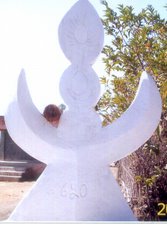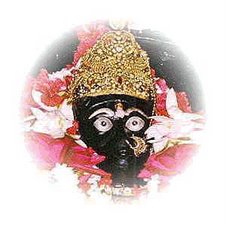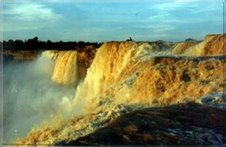To celebrate the 40 years of Naxalbari movement, today we are publishing one important document. This article was published as an editorial in the People's Daily, organ of the central committee of the Communist Party of China on July 5, 1967.
A peal of spring thunder has crashed over the land of India. Revolutionary peasants in the Darjeeling area have risen in rebellion. Under the leadership of a revolutionary group of the Indian Communist Party, a red area of rural revolutionary armed struggle has been established in India. This is a development of tremendous significance for the Indian people’s revolutionary struggle.
In the past few months, the peasant masses in this area, led by the revolutionary group of the Indian Communist Party, have thrown off the shackles of modern revisionism and smashed the trammels that bound them. They have seized grain, land and weapons from the landlords and plantation owners, punished the local tyrants and wicked gentry, and ambushed the reactionary troops and police that went to suppress them thus demonstrating the enormous might of the peasants’ revolutionary armed struggle. All imperialists, revisionists, corrupt officials, local tyrants and wicked gentry, and reactionary army and police are nothing in the eyes of the revolutionary peasants who are determined to strike them down to the dust. The absolutely correct thing has been done by the revolutionary group of the Indian Communist Party and they have done it well. The Chinese people joyfully applaud this revolutionary storm of the Indian peasants in the Darjeeling area as do all Marxist-Leninists and revolutionary people of the whole world.
It is an inevitability that the Indian peasants will rebel and the Indian people will make revolution because the reactionary Congress rule has left them with no alternative. India under Congress rule is only nominally independent; in fact, it is nothing more than a semi-colonial, semi-feudal country. The Congress administration represents the interests of the Indian feudal princes, big landlords and bureaucrat-comprador capitalists. Internally, it oppresses the Indian people without any mercy and suck their blood, while internationally it serves the new boss, U.S. imperialism, and its number one accomplice, the Soviet revisionist ruling clique, in addition to its old suzerain British Imperialism, thus selling out the national interests of India in a big way. So imperialism, Soviet revisionism, feudalism and bureaucrat-comprador capitalism weigh like big mountains on the backs of the Indian people, especially on the toiling masses of workers and peasants.
The Congress administration has intensified its suppression and exploitation of the Indian people and pursued a policy of national betrayal during the past few years. Famine has stalked the land year after year. The fields are strewn with the bodies of those who have died of hunger and starvation. The Indian people, above all, the Indian peasants, have found life impossible for them. The revolutionary peasants in the Darjeeling area have now risen in rebellion, in violent revolution. This is the prelude to a violent revolution by the hundreds of millions of people throughout India. The Indian people will certainly cast away these big mountains off their backs and win complete emancipation. This is the general trend of Indian history which no force on earth can check or hinder.
What road is to be followed by the Indian revolution? This is a fundamental question affecting the success of the Indian revolution and the destiny of the 500 million Indian people. The Indian revolution must take the road of relying on the peasants, establishing base areas in the countryside, persisting in protracted armed struggle and using the countryside to encircle and finally capture the cities. This is Mao Tse-tung’s road, the road that has led the Chinese revolution to victory, and the only road to victory for the revolutions of all oppressed nations and peoples.
Our great leader, Chairman Mao Tse-tung, pointed out as long as 40 years ago: “In China’s central, southern and northern provinces, several hundred million peasants will rise like a mighty storm, like a hurricane, a force so swift and violent that no power, however great, will be able to hold it back. They will smash all the trammels that bind them and rush forward along the road to liberation. They will sweep all the imperialists, warlords, corrupt officials, local tyrants and evil gentry into their graves.”
Chairman Mao explicitly pointed out long ago that the peasant question occupies an extremely important place in the people’s revolution. The peasants constitute the main force in the national-democratic revolution against imperialism and its lackeys; they are most reliable and numerous allies of the proletariat. India is a vast semi-colonial and semi-feudal country with a population of 500 million, the absolute majority of which, the peasantry, once aroused, will become the invincible force of the Indian revolution. By integrating itself with peasants, the Indian proletariat will be able to bring about earth-shaking changes in the vast countryside of India and defeat any powerful enemy in a soul-stirring people’s war.
Our great leader, Chairman Mao, teaches us: “The seizure of power by armed force, the settlement of the issue by war, is the central task and the highest form of revolution. This Marxist-Leninist principle of revolution holds good universally, for China and for all other countries.”
The specific nature of the Indian revolution, like that of the Chinese revolution, is armed revolution fighting against armed counter-revolution; Armed struggle is the only correct road for the Indian revolution; there is no other road whatsoever. Such trash as “Gandhi-ism”, “parliamentary road” and the like are opium used by the Indian ruling classes to paralyse the Indian people. Only by relying on violent revolution and taking the road of armed struggle can India be saved and the Indian people achieve complete liberation. Specifically, this is to arouse the peasant masses boldly, build up and expand the revolutionary armed forces, deal blows at the armed suppression of the imperialists and reactionaries, who are temporarily stronger than the revolutionary forces, by using the whole set of the flexible strategy and tactics of people’s war personally worked out by Chairman Mao, and to persist in protracted armed struggle and seize victory of the revolution step by step.
In the light of the characteristics of the Chinese revolution, our great leader, Chairman Mao, has pointed out the importance of establishing revolutionary rural base areas. Chairman Mao teaches us: In order to persist in protracted armed struggle and defeat imperialism and its lackeys, “it is imperative for the revolutionary ranks to turn the backward villages into advanced, consolidated base areas, into great military, political, economic and cultural bastions of the revolution from which to fight their vicious enemies who are using the cities for attacks on the rural districts, and in this way gradually to achieve the complete victory of the revolution through protracted fighting.”
India is country with vast territory; its countryside, where the reactionary rule is weak, provides the broad areas in which the revolutionaries can manoeuvre freely. So long as the Indian proletarian revolutionaries adhere to the revolutionary line of Marxism-Leninism, Mao Tse-tung’s Thought and rely on their great ally, the peasants, it is entirely possible for them to establish one advanced revolutionary rural base area after another in the broad backward rural areas and build a people’s army of a new type. Whatever difficulties and twists and turns the Indian revolutionaries may experience in the course of building such revolutionary base areas, they will eventually develop such areas from isolated points into a vast expanse, from small areas into extensive ones, an expansion in a series of waves. Thus, a situation in which the cities are encircled from the countryside will gradually be brought about in the Indian revolution to pave the way for the final seizure of towns and cities and winning nation-wide victory.
The Indian reactionaries are panic-stricken by the development of the rural armed struggle in Darjeeling. They have sensed imminent disaster and they wail in alarm that the peasants’ revolt in Darjeeling will “become a national disaster.” Imperialism and the Indian reactionaries are trying in a thousand and one ways to suppress this armed struggle of the Darjeeling peasants and nip it in the bud. The Dange renegade clique and revisionist chieftains of the Indian Communist Party are vigorously slandering and attacking the revolutionaries in the Indian Communist Party and the revolutionary peasants in Darjeeling for their great exploits. The so-called “non-Congress” government in West Bengal openly sides with the reactionary Indian Government in its bloody suppression of the revolutionary peasants in Darjeeling. This gives added proof that these renegades and revisionists are running dogs of U.S. imperialism and Soviet revisionism and lackeys of the big Indian landlords and bourgeoisie. What they call the “Non-Congress government” is only a tool of the landlords and bourgeoisie.
But no matter how well the imperialists, Indian reactionaries and the modern revisionists may cooperate in their sabotage and suppression, the torch of armed struggle lighted by the revolutionaries in the Indian Communist Party and the revolutionary peasants in Darjeeling will not be put out. “A single spark can start a prairie fire”.
The spark in Darjeeling will start a prairie fire and will certainly set the vast expanses of India ablaze. That a great storm of revolutionary armed struggle will eventually sweep across the length and breadth of India is certain. Although the course of the Indian revolutionary struggle will be long and tortuous, the Indian revolution, guided by great Marxism-Leninism, Mao Tse-tung’s Thought, will surely triumph.
source- www.singur-singur.blogspot.com
Subscribe to:
Post Comments (Atom)







No comments:
Post a Comment